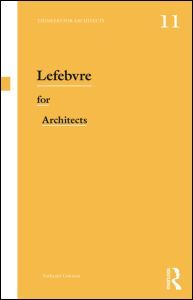Lefebvre for Architects Thinkers for Architects Series
Auteur : Coleman Nathaniel

While the work of Henri Lefebvre has become better known in the English-speaking world since the 1991 translation of his 1974 masterpiece, The Production of Space, his influence on the actual production of architecture and the city has been less pronounced. Although now widely read in schools of architecture, planning and urban design, Lefebvre?s message for practice remains elusive; inevitably so because the entry of his work into the Anglosphere has come with repression of the two most challenging aspects of his thinking: romanticism and Utopia, which simultaneously confront modernity while being progressive.
Contemporary discomfort with romanticism and Utopia arguably obstructs the shift of Lefebvre?s thinking from being objects of theoretical interest into positions of actually influencing practices. Attempting to understand and act upon architecture and the city with Lefebvre but without Utopia and romanticism risks muting the impact of his ideas. Although Utopia may seem to have no place in the present, Lefebvre reveals this as little more than a self-serving affirmation that ?there is no alternative? to social and political detachment. Demanding the impossible may end in failure but as Lefebvre shows us, doing so is the first step towards other possibilities. To think with Lefebvre is to think about Utopia, doing so makes contact with what is most enduring about his project for the city and its inhabitants, and with what is most radical about it as well.
Lefebvre for Architects offers a concise account of the relevance of Henri Lefebvre?s writing for the theory and practice of architecture, planning and urban design. This book is accessible for students and practitioners who wish to fully engage with the design possibilities offered by Lefebvre?s philosophy.
1. Introduction: Lefebvre for Architects Lefebvre for Architects The Problematic of Architecture Lefebvre and Architecture Architecture Thinking Its Own Thoughts 2. Utopia and a New Romanticism Utopia as the Prospect of the Possible Romanticism & Utopia Generate & Degenerate Utopias Critiques of Everyday Life There is no alternative? Or, Lefebvre and Utopia Lefebvre’s Other Vision of Utopia Dialectical Utopianism Experimental and Theoretical Utopias The Utopian Prospect of Lefebvre 3. The Production of Space Problematic of The Production of Space From Space to Place Overcoming Cartesian Logic Representations of the Relations of Production Recuperating the Social Repetition Everywhere Spatial Codes Spatial Practice / Representations of Space / Representational Space The Antithesis of Systems 4. Rhythmanalysis and the TimeSpace of the City Counterpractices for Today Elements of Rhythmanalysis Phenomenology from Your Window? The Perils of Capital The Rhythmanalyst and the Architect 5. Conclusion: Another Scale? Further Reading Bibliography Index
Nathaniel Coleman is Reader in History and Theory of Architecture at Newcastle University, UK. He previously taught in the US, and practiced architecture in New York, USA, and Rome, Italy. Author of Utopias and Architecture (2005) and editor of Imagining and Making the World: Reconsidering architecture and Utopia (2011), Nathaniel recently guest-edited a special issue on architecture of the journal Utopian Studies (2014). He has published numerous journal articles and book chapters, and presented his research on the problem of architecture and Utopia internationally. He is particularly interested in the convergences of architectural history, theory and design with Utopia’s generative potential.
Date de parution : 12-2014
13.8x21.6 cm
Date de parution : 01-2015
13.8x21.6 cm
Thème de Lefebvre for Architects :
Mots-clés :
Adam Sharr; Architecture philosophy; Thinkers for Architects; Henri Lefebvre; The production of space; spatial justice; Nathaniel Coleman; Lefebvre’s Thinking; Total Capture; Vice Versa; Lefebvre’s View; High Modern Architecture; Lefebvre’s Assertion; Lefebvre’s Writing; Le Corbusier; Van Eyck; Lefebvre 1968b; Lefebvre’s Ideas; Lefebvre’s Terms; Aldo Van Eyck; Lefebvre’s Project; Spatial Practices; Spatial Reform; Cobra; Spatial Codes; Dialectical Utopianism; Representational Spaces; Common Language; Duodecimal System; Lefebvre's Distinction; Lunar Module; Abstract Space



